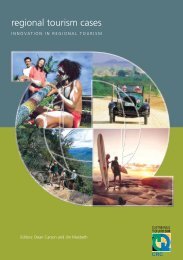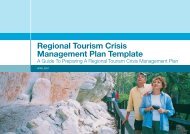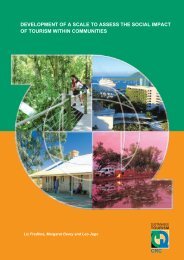Tourism Risk Management - Sustainable Tourism Online
Tourism Risk Management - Sustainable Tourism Online
Tourism Risk Management - Sustainable Tourism Online
You also want an ePaper? Increase the reach of your titles
YUMPU automatically turns print PDFs into web optimized ePapers that Google loves.
established, coordinated and integrated system. The development of effective plans and procedures<br />
in the disaster management context is dependent upon:<br />
• regular inter-agency meetings, networking and liaison;<br />
• implementation of a disaster risk management process;<br />
• development of plans and procedures;<br />
• establishment and nurturing of partnerships;<br />
• community consultation;<br />
• effective communication;<br />
• training of personnel;<br />
• testing of plans, procedures and personnel through exercises (simulated disaster activities);<br />
and<br />
• efficient review and amendment procedures.<br />
The disaster management system in each country will have allocated roles and responsibilities for<br />
the management of disasters. It is not the responsibility of the tourism industry to assign these<br />
responsibilities or to allocate tasks to disaster management agencies. Rather, they should work<br />
within the established framework to add value to the overall outcomes.<br />
Different sections of the tourism industry will have different responsibilities in disaster management,<br />
and will need to liaise at different levels of the disaster management system. National or<br />
state/provincial-level tourism authorities, for example, should participate through membership of<br />
appropriate committees, in national and state/provincial-level disaster risk management processes,<br />
contributing to the development of policy and strategic planning processes. An individual tourism<br />
operator should contribute, again through appropriate committees, to local-level disaster<br />
management processes, including the development of response and recovery plans for the<br />
community, and plans and procedures for tourism facilities (eg, building evacuation plans). At all<br />
levels, disaster management is a multi-agency system.<br />
The second fundamental role for tourism in risk management is to be proactive and develop<br />
strategies for a destination or an individual business/organization to maximize the potential for<br />
continuity of normal business and to protect the safety and security of visitors and staff in the event of<br />
a disaster or crisis.<br />
The development and implementation of tourism risk management strategies which comprehensively<br />
address potential risks to tourism are now becoming an integral part of managing tourism in<br />
destinations. These tourism risk management strategies should link to community disaster<br />
management plans and include actions which tourism operators and organizations can take to<br />
complement the work of community disaster management agencies.<br />
<strong>Risk</strong> management plans for tourism should provide, as appropriate and as a minimum, for:<br />
• the safety of visitors and employees;<br />
• secure systems to communicate with all persons within the facility and within the destination;<br />
• security of buildings, facilities and equipment from the effects of the disaster;<br />
• contributing trained liaison personnel to the disaster management agencies during response<br />
and recovery operations, as required;<br />
• supplying resources to support response and recovery operations; and<br />
• procedures for return to normal business activities upon termination of the disaster<br />
operations.<br />
18 <strong>Tourism</strong> <strong>Risk</strong> <strong>Management</strong> – An Authoritative Guide to Managing Crises in <strong>Tourism</strong>
















